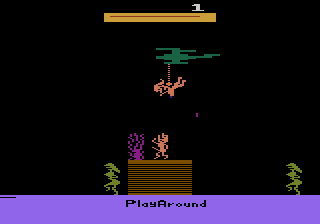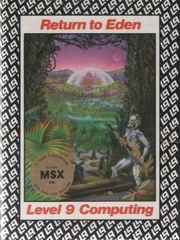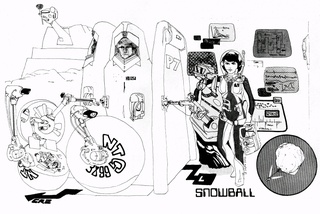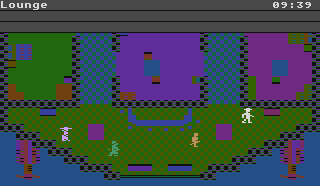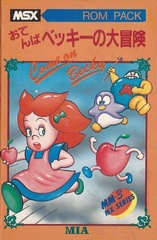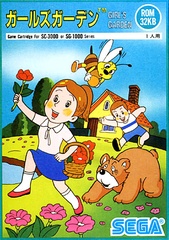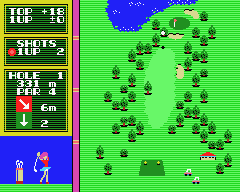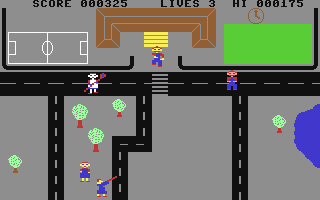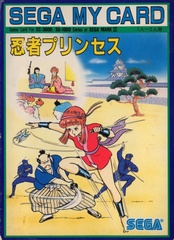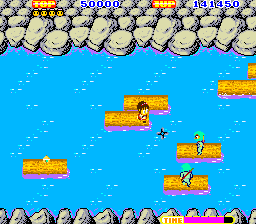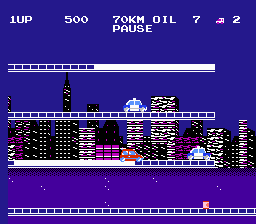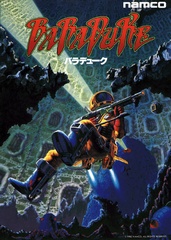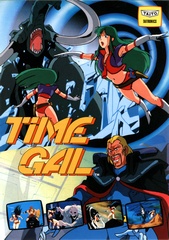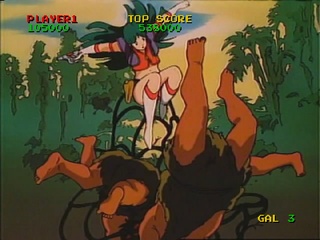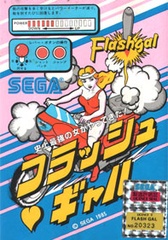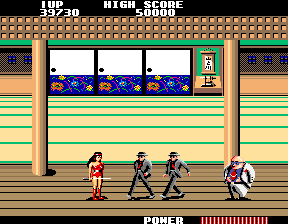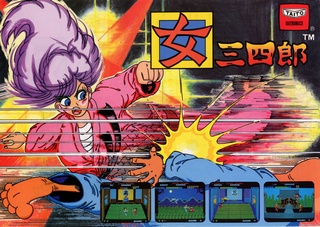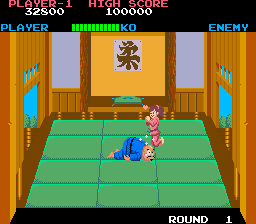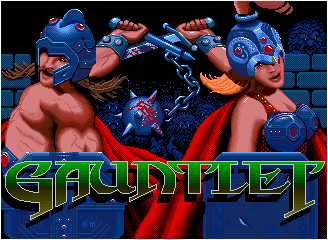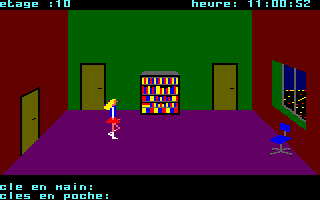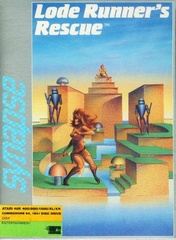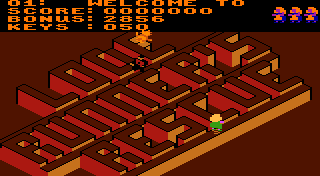Inventories: 1980s Video Game Heroines
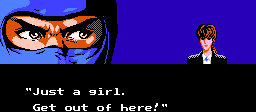
|
<<< Prior Page |
Between Dontnod Entertainment's reports about how hard it was to convince publishers of their reasonably proportioned lead woman in Remember Me, and Ubisoft's claims that athletic female characters are just too difficult to animate to even bother, the video game industry paints a rather sad picture of its diversity. Imagine how bad it must have been back in the 80s, when all game developers were bearded overweight nerd dudes... or was it? Well, let's take a look at all the forms female protagonist have taken in the infant years of gaming, there are quite a few true surprises to be had. But don't take this as an argument to deny that severe gender imbalance among game heroes does exist - never forget that for every single game listed here, there were literally hundreds of bulky barbarians, brash boy wonders, sly spy or ninja dudes and mustachioed plumbers... well, maybe not that many mustachioed plumbers, but you get the point. We won't take just any old protagonist with a double X chromosome, though. But we have a rigid set of requirements that every applicant must meet:
- We only take human-shaped heroines, so good-bye Ms. Pac-Man. A surprisingly common role for female video game player characters is also the mother animal trying to protect/rescue her offspring - be it Kangaroo (1982), Pooyan (1982), Flicky (1984), Onyanko Town (1985), Mama Llama (1985), Bird Week (1986) or, for a more recent example, Shelter (2013). Humanoid fantasy or sci-fi races are allowed, though.
- Games that are adaptions or spin-offs of pre-existing works in other media are not eligible, either. This cuts out the very first example of a female player character in a video game ever, namely Little Red Riding Hood in 1980's Kid Venture. Other popular examples are Ripley in many Alien games and Nausicaä. This does not prevent games that use fictional versions of real life persons showing up in the list, be it officially endorsed or "stolen".
- We won't be listing player-created RPG characters, like the female classes of Dragon Quest III, as well as undefined (aside from their gender) player stand-ins like the female variant in Hitchiker's Guide to the Galaxy or Alter Ego.
- This article focuses mostly on women who are the main characters in their respective games. We have included some women that are additional playable characters or sidekicks, though due to their number, we obviously can't cover ever single game ever made.
Benthi from Galactic Saga IV: Tawala's Last Redoubt (1981)
Galactic Saga was a series of ancient strategic simulations created by Douglas Carlston and published by Broderbund. The first three games follow the career of the male hero Julian du Buque of Sparta from his appointment as commander of Prince Tawala Mundo's armed forces to his eventual rebellion against the emerging despot Emperor. The final game, however, depicts the final struggle on Farside, the last outlier world of Tawala's military power. Commander of the local rebel forces is Benthi (who of course is somehow romantically involved with du Buque). In the game she is only ever assumed to sit in the commander's tent, but in the manual there are several depictions of her, sporting a magnificent afro. May the first original video game heroine even have been conceived as a person of color?
The women from Mystique/PlayAround porn games (1982-1983)
After an impressive start with Benthi, the games industry didn't waste much time to go on a blunt sexploitation spree with a bunch of porn games. The games - there were six different titles - were not entirely original, though: Each of them was the counterpart to a mechanically identical male version, which Playaround later sold as double ender cartridges in various combinations. So Knight of the Town became Lady in Wading, the breakout clone Bachelor Party got the much less imaginative title change Bachelorette Party, and even the infamous Custer's Revenge was appended with General Re-treat, which was only ever released in Europe due to the scandal the original game caused.
Kim Kimberly from Snowball (1983) and Return To Eden (1984)
Kim Kimberly almost didn't count for this list: Kim is a name found with both genders, and the text in the games themselves easily avoids any overt references to gender - it's always "you, the player" in these text adventures. Only in the third game of the Silicon Dreams trilogy her gender is made specific, when you play as some other dude and Kim appears as an NPC. The front covers don't help much, either, as they show either space ships or robot-like combat suits that completely conceal the appearance of the wearer. The cassette inlay (yes, computer games used to come on cassette tapes) for the first game, however, clearly shows a heroine as the agent, with the male crew members suspended in cryostasis. So apparently the publishers' theory that video games with female protagonists on the cover do not sell is not as recent as we might have thought. It's still a mighty step up from the virtual prostitution that preceded the games.
Charity Flair and Agatha Marbles from Murder on the Zinderneuf (1983)
This randomized murder mystery simulator on a blimp features no less than eight playable sleuths with distinct personalities to influence interrogations, and two of them are women. While they are only depicted as silhouettes, Charity Flaire makes suspects talk with her sex appeal, and Agatha Marbles is the sweet elderly woman criminals tend to underestimate until it is too late and they're convicted.
The water ski athlete from Tropical Angel (1983)
Irem is mostly known for the shoot-'em-up series R-Type, but in its early days the company gave Japan its first female video game protagonist. Unsurprisingly the pixel artist went for full sex appeal: The lady waterskis in a bikini, with the bottom hanging suspiciously low. It's also possible to turn around to expose her front, which makes it impossible to steer but is rewarded with bonus points. On the US flyer she is sporting more demure swimwear, but is also shown as needing the guidance of some dude, while she's perfectly fine on her own in the game.
The athletes from Joshi Volleyball (1983), 40-0 (1984) and Field Day (1984)
In the early 1980s, Taito produced a whole series of sports games featuring exclusively female athletes. It probably would mean giving the designers too much credit to assume their motivation was to get more women to play in the arcades rather than getting male players excited at the (crude, by today's standard) graphics, though.
Becky from Otenba Becky no Daibouken / Tomboyish Becky's Large Adventure (1983)
12-year old Becky is playing in her secret hiding place, a mansion with many floors and ladders, when aliens attack. Just as simple as the premise is the game itself, a variant of the "ladder game" genre that was copied so frequently after Space Panic and Donkey Kong.
Jenny from Jenny of the Prairie (1984)
Jenny of the Prairie is a special relic in video game history, as it was the first game that has been documented as created by women, made for girls and starring a girl. It is a graphical survival adventure where Jenny has to find firewood and food for the winter, as well as make a cape for herself. Rihannon Software intended to put out an entire series of games with different themes by creators Elisabeth Stott and Lucy Ewell. The others where titled Cave Girl Clair, Chelsea of the South Sea and Lauren of the 25th Century. Due to the low profile status of most old edutainment software, it's hard to tell which games after Jenny of the Prairie have actually been published, but at least Cave Girl Clair was also completed, and an IBM PC version was dumped recently.
Papri from Girl's Garden (1984)
Years before making his name as the creator of Sonic the Hedgehog Yuji Naka was tasked with creating a game for Sega's very first home console, the primitive SG-1000. As the title lets through, the protagonist is a cute little girl, tending to the flowers in her garden. In retrospect, it still wasn't utterly progressive: The purpose of the heroine's effort is to win - or rather keep - the heart of her boyfriend, who slowly proceeds to cheat on her with another woman, lest he is stopped by a full bouquet of beautiful flowers - that he then gives to her as a present. No, it doesn't make much sense, but video games weren't really expected to in 1984. The most adorable part of the game are the bears that have to be distracted by feeding them honey, though.
The golfers from Queen's Golf and Hole in One (1984)
Early 1980s Japan sure loved its female athletes. The early days of the MSX computer standard saw not one, but two golf games starring women as the golfer, one by ASCII and one by HAL Laboratory.
The Granny from Bionic Granny (1984)
How long do we have to wait before video games free themselves from the boundaries of the young, always sexually attractive yet never sexually active supermodel heroines? No need to wait at all! Thirty years ago, Commodore 64 owners got to play as a crazy old hag who hysterically runs around hitting pedestrians with her cane. That is... not a very favorable depiction. The idea is insane, the game utter garbage, but hey, at least the protagonist is really something else.
Princess Kurumi from Ninja Princess (1985)
At least once, the feminist call for turning around the tired old "damsel in distress" trope in games has apparently been heard long before games even had gotten the attention of feminist discussion. Once again it was Sega who pioneered in more diversive roles for women in video games: At the beginning of the game, the eponymous princess is seen being carried away by an evil usurper's henchmen, but she easily escapes, turns into a ninja and sets out to retake her kingdom all on her own. Might get negative feminist points for the somewhat skimpy and not very ninja-like outfit, though. In the US, the game was circulated as Sega Ninja, presumably trying to trick evil sexist American kids into dropping at least one quarter before they could notice that this game had cooties. A few years later there was a Master System remake that just replaced the Ninja Princes with a dude, even as the Japanese box still read "Ninja Princess 1 Mega Edition". Interestingly, Ninja Princess seems to have kicked off a small wave of fighting ladies in Japanese arcade games, as it was followed by many more in the immediate future.
Claris from City Connection (1985)
Daredevil driver Claris is the poster girl for Jaleco's City Connection - at least in Japan. However, when the NES port was released in the US in 1988, she was replaced by a smug blond guy. A woman as an ace driver? American marketers immediately knew that there was something fishy here! City Connection later experienced a revival in form of the Japan-only mobile title City Connection Rocket, which instead drives the point of the car beeing steered by a lady home as much as it can, with different portraits of her after every stage.
Kissy, Takky and Hommy from Baraduke (1985) and Baraduke II: Bakutotsu Kijūtei (1988)
Just like Metroid one year later, Namco's Baraduke keeps its heroes in a suit that conceals their gender until the very end (and even then the game proclaims: "You are a brave man"). Unlike Samus Aran, their names are a bit of a giveaway, as they sound rather feminine. In the original game, player one is called Kissy and Player two is Takky. In the sequel, Takky is promoted to player one and Hommy is newly introduced as player two. One of the them, presumably Toby Masuyo, is later brought back as a supporting character in the Mr. Driller series, of all things.
Reika Kirishima from Time Gal (1985)
Though Dirk the Daring was obstensibly the star of Dragon's Lair, most teenage boys probably appreciated the presence of his kidnapped lover Princess Daphne. Since her appearances were sparse, though, the developers of Time Gal apparently thought it would be more interesting to make a similar game with a female character at the front and center. And so along comes Reika Kirishima, a green haired time traveler in a skin tight red suit, hailing from the future and getting into trouble in assorted time periods. To avoid any of the ickiness of violence against women - some of Dirk's death's were pretty dark - the failure animations turn into a super deformed art style, making them even more humorous. Though FMV reaction games died after the Sega CD, Reika still ended up showing up as a playable character in Alfa System's Castle Shikigami 3.
Flash Gal from Flash Gal (1985)
The eponymous protagonist of Sega's Flashgal is Wonder Woman. She may be called "Flashgal" for the sake of copyright, but just look at her! As a superheroine clearly inspired by DC's star-spangled Amazon, Flashgal is devoted to punching out crime. The criminal empire in question seems to be headed by a stocky and short bald man in a white suit and shaded glasses, a rather unlikely main villain. The main baddies are gray-suited thugs who look vaguely organized crime-ish, but you can also expect other enemies like hard-to-hit dogs and obnoxious kung-fu fighters who take more than one hit. To break up the potential monotony of beating up mafia goons, there are some levels that take place on vehicles.
Yuki from Onna Sansirou: Typhoon Gal (1985)
Typhoon Gal is the first fighting game with a female playable character. It still won't make feminists happy, though: The heroine Yuki is clad in a "girlish" pink gi, and starts crying when she is defeated. And even though her general design is not sexualized, she is seen hiding behind a tree to change into her fighting gear, throwing her clothes to the wayside. The completely grapple-based fighting system is at least as unusual as the game's main character.
Thyra from Gauntlet (1985)
There is an uncanny frequency of groups that consist of any number of characters including one - and only one - female member. The Smurfs are an extreme example, but the most common occurence is a squad of four or five that includes a token woman. Atari's four-player attempt to bring Dungeons & Dragons style dungeon crawling to the arcades may be the first example in a video game. Unfortunately, Thyra the Valkyrie is generally agreed upon as being the weakest of all four characters.
Amelie Minuit from Amelie Minuit (1985)
In this obscure French (and French only) adventure game, the eponymous Amelie returns to her office at 11 PM to retrieve an important folder she forgot before the building gets locked down for the night. Amelie Minuit as a character is refreshingly ordinary, but unfortunately her task is immediately mundane. It's also impossible and terribly designed. The building contains hundreds of offices, and Amelie doesn't seem to have the slightest clue where she could have left it, or even which of the rooms she ever entered in her entire life. In our test run in an emulator, it was also prone to frequent crashing.
Alexandra from Lode Runner's Rescue (1985)
In a full reversal of the "damsel in distress", the original Lode Runner gets kidnapped, and his daughter has to rescue him. The game's concept at the time was quite unique - instead of taking after the 2D platforming of the original, the heroine has to collect keys in isometric, three-dimensional stages. She's still mostly defined as "someone's daughter", though, and also just a little bit sexualized on the cover. Fun fact: The artist from the seminal video game magazine Electronic Games had already drawn the protagonist of the first game as a woman.
The heroine from Lady Master of Kung-Fu (1985)
The "Lady Master" is just another "sexy fighting gal", but in this case it's the shrouded history of the title that makes it intriguing. It's the first documented game where the protagonist underwent a gender swap at some point during the development - it's just not certain in which direction, and when. There is a variant of this game called "Nunchackun" which features a male protagonist, but it is labeled as an unreleased prototype at Arcade History. However, there doesn't appear to exist any solid proof that Lady Master of Kung Fu was ever released, either. The ending contains a nude image of the protagonist for no good reason.
|
<<< Prior Page |



